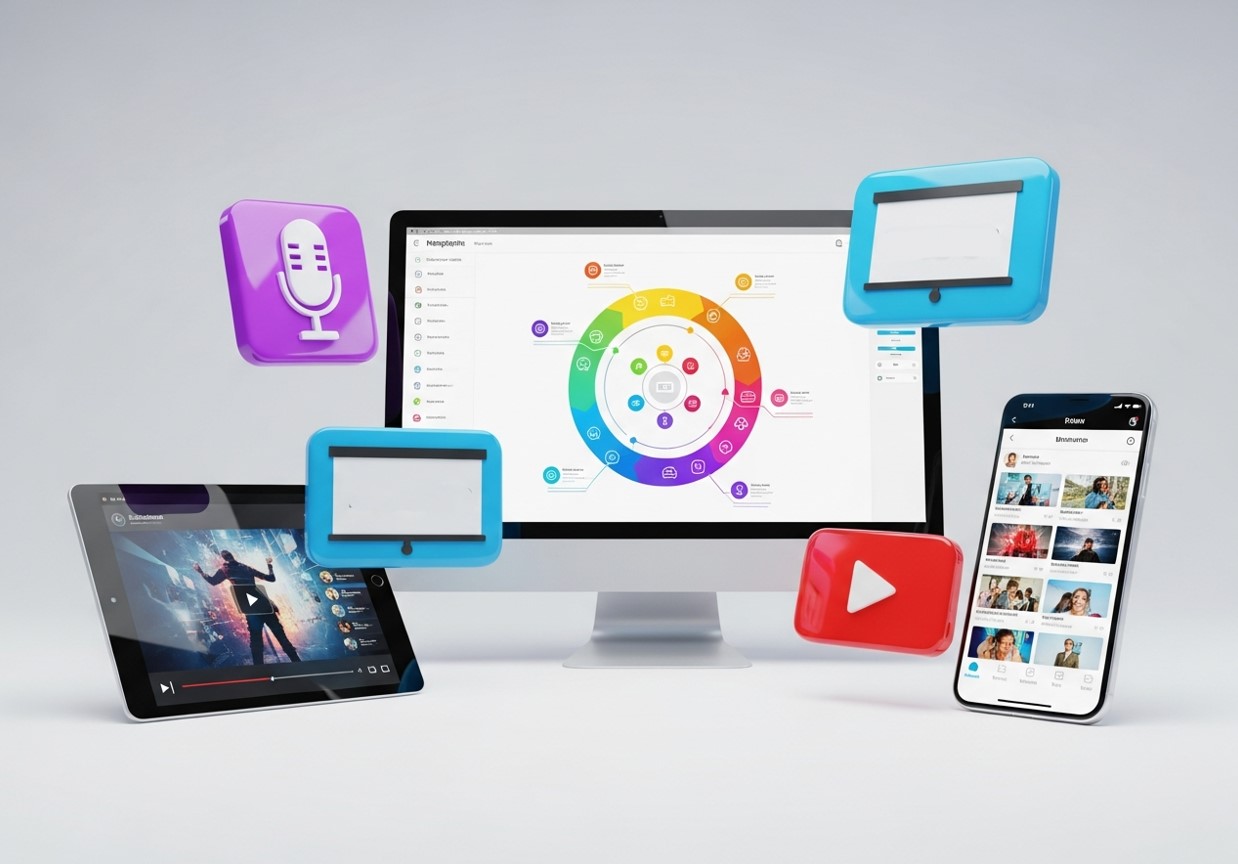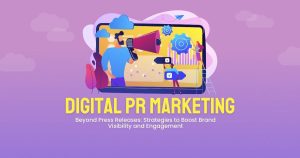Digital PR Content Marketing: Your Guide to Earned Media Success

Digital PR content marketing uses strategic content and multimedia to build brand authority, earn media coverage, and engage audiences effectively.
Digital PR content marketing is the convergence of old-school PR and content generation that’s defined by a strategy. It’s a winning formula, enabling brands to form authentic relationships with both journalists, influencers, and their audience, all the while securing valuable media coverage that leads to traffic, authority, and visibility.
Unlike traditional advertising, Digital PR content marketing is all about persuading people to share content so stunning that it’s difficult to imagine how the media wouldn’t write about it. In this extensive guide, you’ll learn how to use content marketing as part of your digital PR strategy to earn press coverage and organic links that you can measure.
Understanding Digital PR Content Marketing
Digital public relations content marketing melds the friendship-forging of PR with the tactical content building of marketing. The aim is to generate good stories and useful information that journalists want to write and audiences want to read.
There are many things about this that make it different from traditional PR. Old school PR often involves press releases and media pitches about company news. Digital PR content marketing, on the other hand, produces proprietary research, expert analysis, and data-driven narratives that actually mean something to the people you want to reach.
The content becomes its own publicity. You could explore trends and statistics in the industry and then report these findings (instead of promoting a new product). This makes you the expert before the brand so that you’re telling a journalist news that he/she doesn’t already know. If you want strategies that are game-changing for modern brands, check out Digital PR marketing game-changer.
Elements of Every Successful Digital PR Content Type

Original Research and Data Studies
The best digital PR campaigns are underpinned by content that is informed by data. Original research gets media coverage because it offers up a new angle to journalists and a jumping-off point.
Try doing short surveys in your market, or study the trends and facts you collect to find something new. When you package that research up in an easily digestible format, reporters reference your data in their stories, which acts as a chain of backlinks and brand mentions. For more on earning quality links through content, see Earning high-quality backlinks with Digital PR.
Research content is only as successful as a well-thought-out plan. Begin by highlighting shortcomings in current industry knowledge. What questions do people you encounter in your industry often ask? What evidence would help them decide better?
Expert Commentary and Thought Leadership
By positioning company executives as pundits, the firm keeps itself in the media. This requires building a cohesive voice on industry matters and making expertise easily accessible to reporters.
Produce content with a new angle on industry news. These might involve dissecting fresh legislation, forecasts regarding market swings, or teaching non-industry readers about confusing sector issues.
Thought leadership building takes time, and it needs to be genuine. Select subjects that complement your business knowledge and keep to a predetermined publishing schedule. Eventually, journalists will refer to your brand as a go-to for expert commentary.
Interactive Content and Tools
Interactive content = engagement and the ability to secure natural media opportunities. This can be calculators, assessments, quizzes, or interactive infographics that answer questions for your niche.
That’s why these tools have been written about in the media _ they are useful to readers. A mortgage calculator could merit attention in personal finance publications, while a productivity evaluation would appeal to business reporters.
You need to develop tools that solve real problems within your market. Look for things that solve real problems your audience is facing regularly, and make sure these are actually useful tools, not just disguised sales content.
Building Relationships Through Content
Creating Journalist-Friendly Resources
That couldn’t be further from the truth for successful digital PR content marketing. Reporters on deadline love content that’s easy for readers to understand, presents a well-researched argument, and is immediately useful for their readers.
Create resources made just for the media. This could be industry reports featuring important stats, expert quotes tailored for different angles to the story, visuals that can be used alongside your written content, etc.
Also, think about putting together a media room on your site where members of the press can download various high-resolution images, headshots of company executives, company statistics, recent research results, etc. That makes it easier for reporters to include your brand in their articles.
Creating Series and Open-Ended Content
Relationships develop when content is provided consistently, over just in one-off campaigns. Create regular content series that offer continued value to readers and media contacts.
These could be monthly industry reports, quarterly market trends studies, or weekly expert analysis of the news. Creating content consistently keeps your brand in front of people and offers several opportunities for media coverage.
Content series also contributes to establishing your brand as a thought leader in the long run. When reporters seek comment on industry issues, they are more likely to reach out to sources who regularly offer a timely and knowledgeable perspective.
Content Distribution Strategies

Multi-Channel Approach
When creating a PR content marketing campaign, the pattern for a campaign structure may look like the following for a PR initiative through digital tactics: 1) An artful digital content distribution plan. This will maximize exposure and create multiple media-pickup options.
Begin by creating content on your owned channels such as your website, blog, and social media profiles. That way, your profile establishes enough credibility to impress journalists who research your brand.
Increase your distribution through industry publications, guest posting, and content syndication. The two channels offer unique benefits and reach different audiences.
Social Media Amplification
Social media is also one of the featured distribution channels for digital PR content. They serve to amplify your message and drive chargeability and media discovery.
Your strategy is made up of a variety of platforms that serve different purposes. LinkedIn is great for B2B thought leadership content, while Twitter provides a hotbed for journalists and influencer engagement.
Develop channel-specific content that tailors your central message to suit the audience and format of each iterative platform. This optimizes involvement by ensuring consistent messaging across all channels.
Influencer and Partnership Collaborations
Partnering with industry thought leaders and colleagues helps boost your content’s reach and reliability. These partnerships also offer new audiences, as well as a chance to co-produce content.
Understand the key influencers that own audiences similar to your target market. Concentrate on creating real relationships instead of business deals. Real collaborations always work better than sponsored promotions.
Maybe you can co-produce content with similar businesses or industry leaders. It’s a win-win scenario where both parties can create more in-depth and higher caliber work for their readers.
Crisis Communication and Reputation Management
Digital PR content marketing is not just about promotion—it’s also about protecting your brand’s reputation. When a crisis emerges, proactive content strategy is crucial. Brands can utilize real-time monitoring tools to track media mentions, social sentiment, and audience discussions. With this information, PR teams can craft timely, accurate, and transparent responses to mitigate reputational damage.
Thoughtful messaging during a crisis demonstrates accountability and can even strengthen trust among stakeholders. Integrating crisis communication into your digital PR plan ensures that your brand remains responsive and prepared, turning potentially negative situations into opportunities to showcase professionalism and transparency.
Story Amplification Through Multimedia
In the digital age, storytelling extends beyond written content. Multimedia—such as videos, podcasts, interactive infographics, and webinars—enhances engagement and extends reach. Journalists and influencers are more likely to feature content that provides rich media assets, as it saves time and improves the audience experience.
For example, a brand releasing a research report could accompany it with a short explainer video, an infographic summarizing key findings, and social media snippets designed for sharing. These assets make the content more dynamic, increase audience retention, and encourage organic amplification through shares, embeds, and links, solidifying the impact of your PR efforts.
Nurturing Long-Term Media Relationships
Sustained relationships with journalists, bloggers, and industry influencers are a cornerstone of Digital PR success. This isn’t about transactional outreach; it’s about consistently providing value. By delivering well-researched content, exclusive insights, and timely commentary, brands position themselves as trusted sources.
Over time, these relationships reduce the effort needed to secure coverage, as journalists naturally turn to your brand for expert opinions. It’s a strategic investment in trust, credibility, and visibility. Personalized communication, transparency, and reliability are the key pillars of lasting media partnerships.
Measuring the ROI of Digital PR Content Marketing
Unlike traditional PR, digital PR allows for granular measurement of performance. Metrics like media mentions, backlinks, social engagement, referral traffic, and content downloads provide a clear picture of campaign effectiveness. Advanced analytics can also connect earned media to conversions, leads, or revenue, demonstrating the tangible business impact.
By continuously tracking and analyzing these metrics, brands can refine strategies, identify high-performing content types, and allocate resources more efficiently. Long-term tracking also helps assess shifts in brand authority, sentiment, and awareness, validating the effectiveness of content-driven PR campaigns.
Personalization and Targeted Campaigns
Personalization in Digital PR ensures that content reaches the right audience at the right time. Brands can segment media lists, targeting journalists, influencers, and audiences based on interests, previous coverage, and engagement patterns. Tailoring pitches to demonstrate relevance increases coverage success rates.
Similarly, personalized content marketing campaigns aimed at specific audience segments can be distributed through email, social channels, or partner networks. This dual approach—targeted pitching and audience-focused storytelling—creates more meaningful engagement, increases the likelihood of shares, and strengthens the brand’s position as an industry authority.
Emerging Trends in Digital PR Content Marketing
The digital PR landscape is constantly evolving. Emerging trends include AI-driven content creation, predictive analytics for media outreach, interactive content, voice search optimization, and AR/VR experiences. Brands embracing these innovations are better positioned to capture audience attention and earn media coverage.
For instance, AI tools can identify trending topics in your niche and suggest story angles likely to attract journalists. Similarly, predictive analytics can determine which journalists or influencers are most likely to engage with your content, increasing efficiency and impact. Staying ahead of trends ensures that your PR strategy remains modern, competitive, and highly effective.
Measuring Success and ROI

Key Performance Indicators
To track success in PR you need to be measuring traditional PR metrics and content marketing KPIs. This is more of a holistic view of how well your campaigns are working.
Use media mentions, backlinks, and share of voice to track PR impact. Track content engagement, traffic, and lead turnout to measure the efficiency of your marketing.
Metrics of quality matter as much as quantities. One mention in a large industry magazine could be worth more than 20 smaller mentions. Priorities metrics that are in line with your overall business goals.
Long-Term Brand Building
Brand authority is built through digital PR content marketing over time. The compound impact of all this may be hard to measure, but it adds up over time.
Track how the brand sentiment, search ranking, and industry recognition are improving. These metrics indicate the bank of brand authority and market positioning.
You might also do some brand awareness surveys from time to time to monitor a shift in perception of the market. This is one way of seeing the impact of your content efforts in terms of brand recognition and trust.
How to Get the Most of Your Digital PR ‘Content Marketing’ and Make Your Buck Go Further
Where digital PR content marketing is strong There’s a huge opportunity to build brand authority, get media coverage and generate business results. Success depends on being strategic, steady and focused on delivering real value to both the media and your audiences.
Begin by determining your distinct expertise and the narratives only your brand can share. Develop content that showcases this knowledge and at the same time, solves legitimate problems of your potential client base. Forge relationships with journalists and influencers by offering them valuable assets and keeping them in the loop.
Don’t forget you’re playing the long game with your digital PR content marketing. Results accrue as you become more credible or more of an insider or even an expert in your field. Just focus on producing great content that meets your audience’s wants/needs, and the media will follow.
While Digital PR is focused on building brand credibility and authority through earned media, it’s also important to understand how other digital channels contribute to the overall strategy. If you’re exploring ways to drive traffic and generate revenue through partnerships, take a look at our in-depth breakdown of How Affiliate Marketing Fits into a Winning Digital Marketing Strategy. It offers a complementary view of how performance-based marketing works alongside earned media initiatives.
Frequently Asked Questions (FAQ)
What is digital PR content marketing?
It is the integration of traditional PR with strategic content creation, aimed at generating media coverage, backlinks, and brand authority while engaging target audiences.
How does original research benefit PR campaigns?
Original research provides unique insights that journalists and audiences find valuable, increasing the likelihood of coverage, backlinks, and social sharing.
Can multimedia improve PR outcomes?
Yes. Videos, interactive tools, and infographics make content more engaging, easier to share, and more likely to be picked up by journalists.
How do I measure the success of a digital PR campaign?
Track media mentions, backlinks, social engagement, referral traffic, conversions, and overall shifts in brand sentiment and authority.
Is personalization important in digital PR?
Absolutely. Tailored pitches and audience-specific content increase coverage success, engagement, and overall campaign effectiveness.
What are key trends to watch in digital PR content marketing?
AI-driven content, predictive outreach, interactive experiences, voice search optimization, and AR/VR content are emerging trends that can enhance campaign impact.
How can I maintain strong journalist relationships?
Provide value consistently, communicate transparently, offer timely insights, and nurture trust through reliability and expertise.





